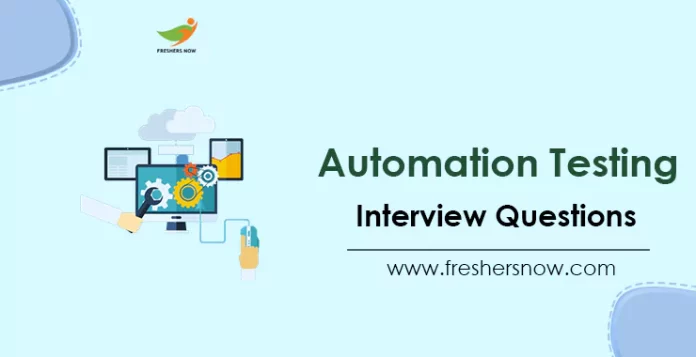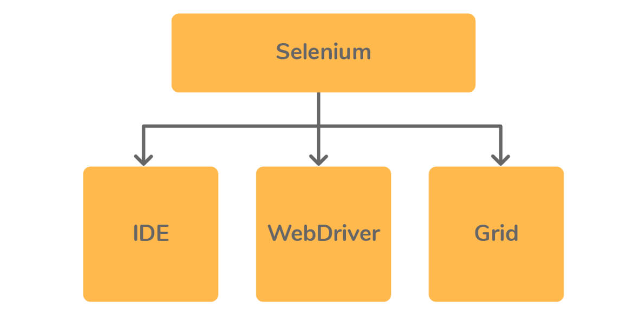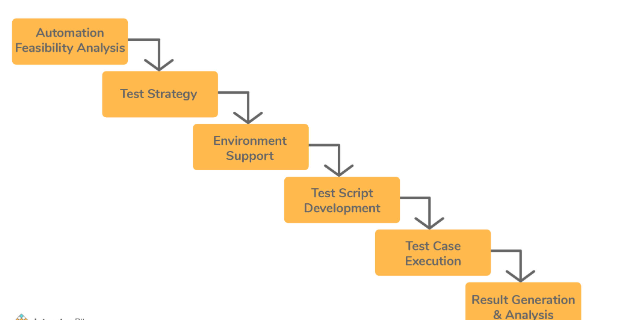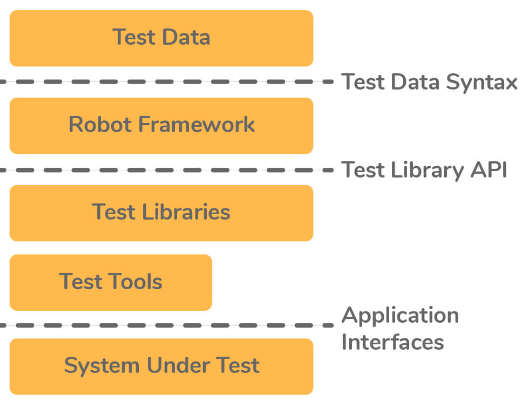
Top 50 Automation Testing Interview Questions and Answers: Being well-prepared for an Automation Testing Technical Interview is crucial since employers seek competent candidates in this critical component of software development.
★★ Latest Technical Interview Questions ★★
Automation Testing Interview Questions and Answers
Whether you’re an experienced Automation Testing professional or new to the field, this comprehensive Top 50 Automation Testing Interview Questions and Answers will help you prepare for your next interview. Automation Testing Interview Questions for Freshers will give you the confidence you need to succeed. So let’s jump in and start learning!
Top 50 Automation Testing Interview Questions and Answers
1. What is automation testing, and how does it differ from manual testing?
Automation testing is the use of software tools to automate the execution of test cases, while manual testing involves human testers manually executing test cases. The primary difference is that automation testing is faster, more efficient, and less prone to human error.
2. What are the different components of Selenium?
- Selenium WebDriver: A collection of open-source APIs and browser-controlling code implementations. Provides a concise and straightforward programming interface.
- Selenium Grid: Enables the tester to run multiple tests across different browsers, machines, and operating systems in parallel.
- Selenium IDE: Stands for Integrated Development Environment. Allows the tester to write, record, run and debug test cases.

3. What are the benefits of automation testing?
Automation testing has several benefits, including improved efficiency, accuracy, repeatability, and coverage. It also allows for earlier detection of defects, reduces time and costs, and enables testing to be performed on a larger scale.
4. What are the drawbacks of automation testing?
Automation testing has some drawbacks, such as the initial cost and time investment required to create and maintain automated test suites. Automation testing may also have limitations in certain testing scenarios, such as those involving user interface or usability testing.
5. Can all tests be automated? Why or why not?
Not all tests can be automated. Certain tests, such as those involving subjective or visual evaluation, require human judgment and cannot be automated. Additionally, some tests may not be cost-effective to automate.
6. What are the different phases in an automation testing life cycle?
- Figure out the scope of automation testing
- Choose the correct automation frameworks and tools
- Design a test plan + test execution strategy
- Set up the test environment
- Development and execution of the test cases
- Analysis and generation of test reports

7. What are the most commonly used automation testing tools?
Some commonly used automation testing tools include Selenium, Appium, TestComplete, HP UFT, and JUnit.
8. How do you select the right automation testing tool for a project?
The right automation testing tool depends on various factors such as project requirements, budget, technology stack, and team skills. Evaluating the pros and cons of different tools and conducting proof-of-concept tests can help in selecting the appropriate tool.
9. What are the challenges you have faced in automation testing, and how did you overcome them?
Some common challenges in automation testing include maintaining test scripts, managing test data, handling dynamic elements, and integrating with other tools. Overcoming these challenges often involves good planning, communication, collaboration, and a solid understanding of the tools and technologies being used.
10. What is the Robot framework? Provide a brief overview of its architecture.
The Robot Framework is a widely used open-source automation testing framework that is primarily utilized for robotic process automation (RPA). RPA involves replicating human actions and interactions with software. Similar to humans, the framework can comprehend what is displayed on the screen, click buttons and keys, browse to links, and extract data.
This framework is developed in Python and can function on any operating system. The majority of the libraries in the ecosystem are also open-source. The Robot Framework’s modular architecture enables extension with other libraries, and it defines test data in files utilizing a distinct syntax exclusive to the framework. Test suites may include numerous such tests.

11. How do you determine what tests to automate and what tests to perform manually?
Tests that are repetitive, time-consuming, and require precise execution are good candidates for automation. Tests that are subjective, exploratory, or require human judgment are better performed manually.
12. How is regression testing different from retesting?
| Topic | Regression Testing | Retesting |
|---|---|---|
| Definition | Testing to ensure changes made in the codebase do not affect previously tested functionality. | Testing to ensure that bugs found and fixed in a previous test cycle are indeed resolved. |
| Objective | Verifies that changes in the codebase do not break previously tested functionality. | Verifies that previously found and fixed bugs no longer exist in the system. |
13. What is the difference between unit testing and functional testing?
Unit testing involves testing individual code units or modules in isolation, while functional testing involves testing the entire system or application as a whole. Unit testing is often done by developers, while functional testing is typically done by testers.
14. What is the difference between smoke testing and regression testing?
Smoke testing is a quick, high-level test of the system to ensure that critical functionality works, while regression testing involves retesting the system after changes to ensure that existing functionality has not been impacted.
15. What distinguishes functional testing from non-functional testing?
| Topic | Functional Testing | Non-Functional Testing |
|---|---|---|
| Definition | Testing the system’s behavior based on functional requirements. | Testing the system’s behavior based on non-functional requirements. |
| Objective | Verifies if the system meets its functional requirements. | Verifies if the system meets its non-functional requirements, such as performance, security, and usability. |
| Examples | Unit testing, Integration testing, System testing | Performance testing, Security testing, Usability testing |
16. What is the purpose of load testing?
The purpose of load testing is to test the system’s ability to handle high levels of user traffic or activity. It helps identify performance bottlenecks, scalability issues, and system limits.
17. What is the difference between XPath and CSS Selector in Selenium?
XPath uses path expressions to select elements in an HTML document, whereas CSS Selector uses selectors to match elements in an HTML document. XPath is more powerful and can select elements based on complex conditions, while CSS Selector is simpler and faster.
18. How would you handle dynamic elements on a web page during automation testing?
Dynamic elements can be handled using wait statements or by using explicit waits, which will wait for an element to appear on the page before proceeding with the test.
19. What are some best practices for writing effective automated test cases?
Some best practices for writing effective automated test cases include writing clear and concise test cases, ensuring test data is consistent, and using descriptive naming conventions for test methods.
20. Can you explain the concept of object repository in automation testing?
The object repository is a central location where test objects are stored for easy retrieval during test execution. It helps in reducing the maintenance effort of test scripts.
21. How would you handle exceptions in Selenium?
Exceptions can be handled using try-catch blocks, where the code inside the try block is executed, and if an exception occurs, it is caught in the catch block.
22. Can you explain the difference between unit testing and integration testing?
Unit testing is performed on individual units of code, such as functions or methods, whereas integration testing is performed on the system as a whole to test how different components interact with each other.
23. What is a test automation framework, and why is it essential?
The test automation framework is a set of guidelines and rules for writing and organizing test cases. It is essential because it provides structure and consistency to test automation, which can help reduce maintenance efforts and improve test coverage.
24. Can you explain the difference between black-box testing and white-box testing?
Black-box testing is testing without knowledge of the internal workings of the system, whereas white-box testing is testing with knowledge of the internal workings of the system.
25. How would you handle pop-up windows during automation testing?
Pop-up windows can be handled using the switch () method, which allows you to switch between windows and frames during test execution.
26. How does manual testing differ from automated testing?
| Topic | Manual Testing | Automated Testing |
|---|---|---|
| Definition | Testing is performed manually by human testers. | Testing is performed using automated scripts and tools. |
| Objective | Verifies the system’s behavior, functionality, and user experience. | Verifies the system’s behavior, functionality, and performance. |
| Advantages | Offers a more intuitive and exploratory approach to testing. | Offers a faster, more consistent, and repeatable testing approach. |
27. Can you explain the role of TestNG in automation testing?
TestNG is a testing framework that allows you to write and run test cases in a more efficient manner. It supports various features such as parallel test execution, the grouping of test cases, and test case dependency management, which can help improve the efficiency and effectiveness of test automation.
28. What is the difference between performance testing and load testing?
- Performance testing measures system performance under various conditions, including load, stress, and endurance.
- Load testing specifically measures the system’s ability to handle a large number of users or transactions.
29. What is the difference between test cases and test scenarios?
- Test cases are specific instructions that outline how to test a particular feature or function of the system.
- Test scenarios are broader, outlining a set of steps and conditions to test a particular user flow or use case.
30. What is the difference between black box testing and white box testing?
- Black box testing tests the system without knowledge of its internal workings, focusing on inputs and outputs.
- White box testing tests the system with knowledge of its internal workings, focusing on code-level testing.
31. What distinguishes smoke testing from sanity testing?
| Topic | Smoke Testing | Sanity Testing |
|---|---|---|
| Definition | A quick and shallow round of testing to ensure that the system’s critical functionality is operational. | A deeper round of testing to ensure that changes made in the codebase do not affect critical functionality. |
| Objective | Verifies that the system’s most critical features are operational. | Verifies that changes made to the codebase do not affect the system’s critical features. |
32. How do you prioritize your test cases?
Test cases can be prioritized based on factors such as criticality, risk, and likelihood of failure.
33. How do you write effective test cases?
Effective test cases should be clear, concise, and repeatable. They should cover all possible scenarios and be written with an understanding of the user’s perspective.
34. What is a traceability matrix, and why is it important in automation testing?
A traceability matrix is a document that links requirements to test cases, ensuring that all requirements are tested. It is important in automation testing because it helps ensure test coverage and maintainability.
35. What is the difference between load testing and stress testing?
| Topic | Load Testing | Stress Testing |
|---|---|---|
| Definition | Testing the system’s ability to handle normal and expected loads. | Testing the system’s ability to handle unexpected and abnormal loads. |
| Objective | Verifies the system’s performance under normal and expected loads. | Verifies the system’s performance under unexpected and abnormal loads. |
36. How do you identify and report defects in automation testing?
Defects can be identified through automation test results, logs, and system errors. They should be reported in a clear and concise manner, outlining the steps to reproduce the issue.
37. What is the difference between black box testing and white box testing?
| Topic | Black Box Testing | White Box Testing |
|---|---|---|
| Definition | Testing based on external behavior and functionality without internal knowledge of the codebase. | Testing based on internal knowledge of the codebase and its implementation details. |
| Objective | Focuses on verifying the system’s external behavior and user experience. | Focuses on verifying the system’s internal logic and structure. |
38. How do you ensure that your automation test suite is maintainable?
Automation test suites can be made maintainable through good code organization, modularization, and using automation frameworks that promote maintainability.
39. How do you handle unexpected errors during automation testing?
Unexpected errors can be handled through exception handling and logging. They should be reported and investigated to prevent future errors.
40. What is data-driven testing, and how is it useful in automation testing?
Data-driven testing involves running the same test case with different sets of test data. It is useful in automation testing because it can increase test coverage and efficiency.
41. What is keyword-driven testing, and how is it useful in automation testing?
Keyword-driven testing is a testing approach where tests are written in a tabular format using a set of keywords. It is useful in automation testing because it provides a way to create reusable test scripts.
42. What is hybrid testing, and how is it useful in automation testing?
Hybrid testing is a combination of data-driven testing and keyword-driven testing. It is useful in automation testing because it allows for both flexibility and reusability.
What is the difference between an automation framework and an automation script?
- An automation framework is a set of guidelines and rules for creating and organizing automation scripts.
- An automation script is a specific set of instructions written in a programming language to automate a particular function or feature of the system.
43. What is the difference between unit testing and integration testing?
| Topic | Unit Testing | Integration Testing |
|---|---|---|
| Definition | Testing individual units or components of a system in isolation. | Testing multiple integrated components of a system as a group. |
| Scope | Focuses on verifying the behavior of a specific code unit or function. | Focuses on verifying the behavior of multiple code units working together. |
| Dependencies | Usually performed in isolation, without external dependencies. | Performed with external dependencies, such as databases and APIs. |
| Objective | Detects and eliminates bugs and errors in code units before integration. | Detects and eliminates bugs and errors in integrated code units. |
44. When selecting an automation tool, what features will you look for?
Here are some of the features to look for when selecting an automation tool:
- Test Environment support,
- Ease of use,
- Debugging features,
- Testing capabilities for various elements,
- UI element identification features,
- Should allow database testing.,
- Should support multiple frameworks
45. What is usability testing?
It is a testing methodology where the end customer is asked to use the software to see if the product is easy to use and to see the customer’s perception and task time. An accurate way to finalize the customer’s point of view on usability is by using prototype or mock-up software during the initial stages.
46. What are the benefits of Automation testing?
The benefits of Automation testing are:
- Supports execution of repeated test cases
- Aids in testing a large test matrix
- Enables parallel execution
- Encourages unattended execution
- Improves accuracy thereby reducing human-generated errors
- Saves time and money
47. On what basis you can arrive at an estimation for your project?
To estimate your project, you have to consider the following points:
- Divide the whole project into the smallest tasks
- Allocate each task to team members
- Estimate the effort required to complete each task
- Validate the estimation
48. Which test cases can be automated?
- Smoke test cases
- Regression test cases
- Complex calculation test cases
- Data-driven test cases
- Non-functional test cases
49. What are the different strategies for rollout to end users?
The strategies to be followed for the rollout are as follows:
- Pilot
- Gradual Implementation
- Phased Implementation
- Parallel Implementation
50. How to take screenshots in Selenium WebDriver?
By using the TakeScreenshot function you can take a screenshot. With the help of the get screenshots () method, you can simply save that screenshot.
Example:
File scrFile = ((TakeScreenshot)driver).getScreenshotAs(outputType.FILE);
If you are looking to excel in Automation Testing technical interviews, then our Top 50 Automation Testing Interview Questions and Answers can provide valuable insights for both freshers and experienced professionals. By following us at freshersnow.com., you can expand your knowledge and stay updated on the latest information. Don’t miss out on this opportunity to enhance your career prospects in Automation Testing.



